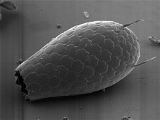
Euglyphid
Encyclopedia
The euglyphids are a prominent group of filose amoeba
e that produce shells or tests from siliceous scales, plates, and sometimes spines. These elements are created within the cell and then assembled on its surface in a more or less regular arrangement, giving the test a textured appearance. There is a single opening for the long slender pseudopods, which capture food and pull the cell across the substrate.
Euglyphids are common in soils, marshes, and other organic-rich environments, feeding on tiny organisms such as bacteria
. The test is generally 30-100 μm in length, although the cell only occupies part of this space. During reproduction a second shell is formed opposite the opening, so both daughter cells remain protected. Different genera and species are distinguished primarily by the form of the test. Euglypha and Trinema are the most common.
The euglyphids are traditionally grouped with other amoebae. However, genetic studies instead place them with various amoeboid and flagellate
groups, forming an assemblage called the Cercozoa
. Their closest relatives are the thaumatomonad
s, flagellates that form similar siliceous tests.
Amoeboid
Amoeboids are single-celled life-forms characterized by an irregular shape."Amoeboid" and "amœba" are often used interchangeably even by biologists, and especially refer to a creature moving by using pseudopodia. Most references to "amoebas" or "amoebae" are to amoeboids in general rather than to...
e that produce shells or tests from siliceous scales, plates, and sometimes spines. These elements are created within the cell and then assembled on its surface in a more or less regular arrangement, giving the test a textured appearance. There is a single opening for the long slender pseudopods, which capture food and pull the cell across the substrate.
Euglyphids are common in soils, marshes, and other organic-rich environments, feeding on tiny organisms such as bacteria
Bacteria
Bacteria are a large domain of prokaryotic microorganisms. Typically a few micrometres in length, bacteria have a wide range of shapes, ranging from spheres to rods and spirals...
. The test is generally 30-100 μm in length, although the cell only occupies part of this space. During reproduction a second shell is formed opposite the opening, so both daughter cells remain protected. Different genera and species are distinguished primarily by the form of the test. Euglypha and Trinema are the most common.
The euglyphids are traditionally grouped with other amoebae. However, genetic studies instead place them with various amoeboid and flagellate
Flagellate
Flagellates are organisms with one or more whip-like organelles called flagella. Some cells in animals may be flagellate, for instance the spermatozoa of most phyla. Flowering plants do not produce flagellate cells, but ferns, mosses, green algae, some gymnosperms and other closely related plants...
groups, forming an assemblage called the Cercozoa
Cercozoa
The Cercozoa are a group of protists. They are sometimes described as a kingdom.-Characteristics:The group includes most amoeboids and flagellates that feed by means of filose pseudopods. These may be restricted to part of the cell surface, but there is never a true cytostome or mouth as found in...
. Their closest relatives are the thaumatomonad
Thaumatomonad
Thaumatomonadida is an order of flagellates....
s, flagellates that form similar siliceous tests.

